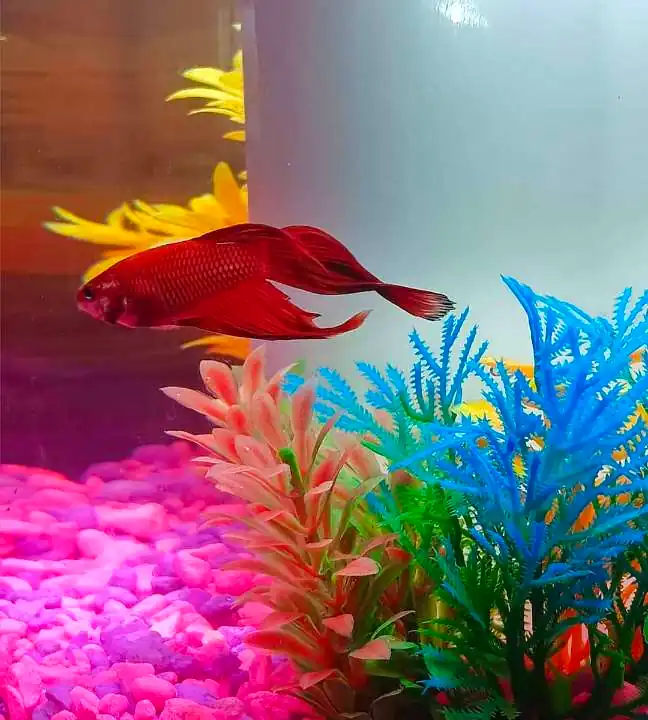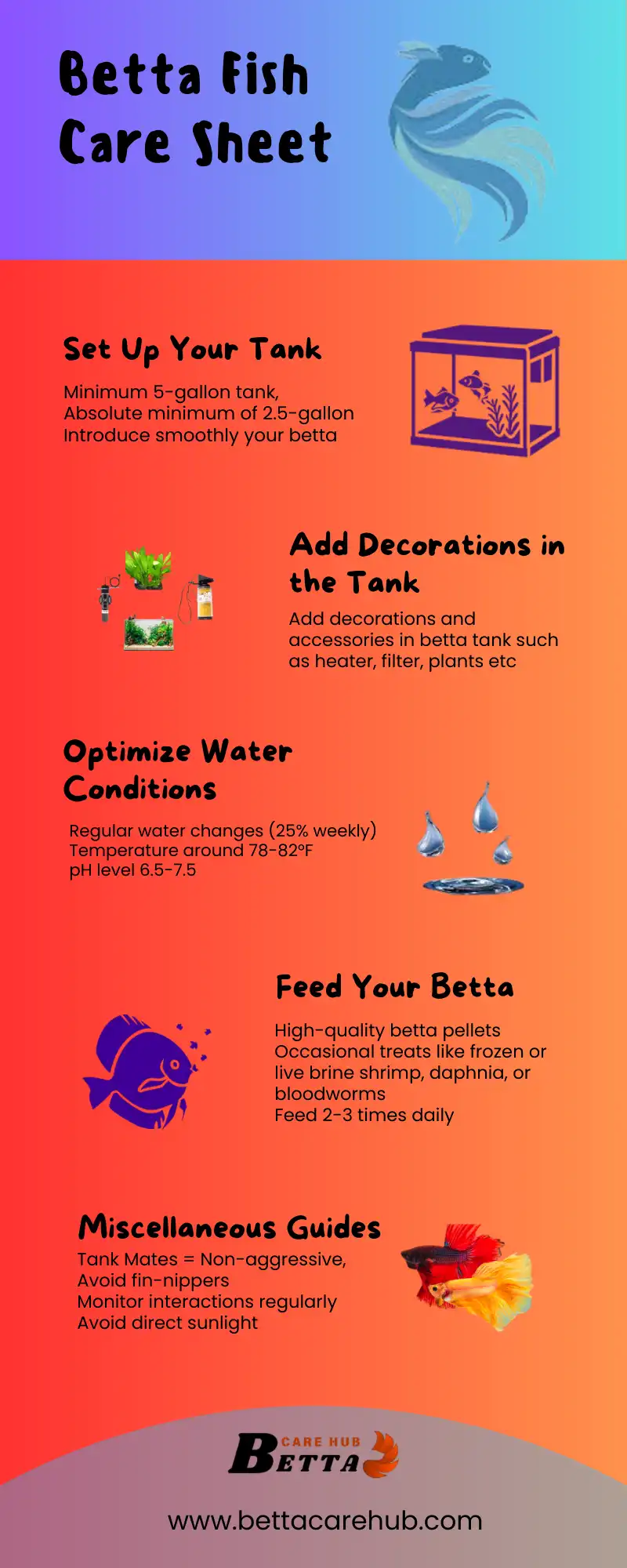Tank Size
The journey of caring for a betta fish begins with choosing the right-sized tank. Taking care of it is pretty easy if you start correctly. Setting up the right size tank is like creating the perfect habitat for your betta. A tank is not just a water storage; it’s a dwelling place and, even more, a home for your betta. An ideal tank allows for proper monitoring of everything inside it, which is essential for optimal betta fish care.
The most recommended size for a betta fish is 5 gallons, while 2.5 is the absolute minimum. The smaller the tank, the more maintenance it requires. Therefore, we recommend a larger tank (at least 5-10 gallons), so your betta has more space to swim and explore. Never keep a betta in tiny bowls; it will degrade your pal’s health. Discover essential insights about the perfect tank size for your betta fish on our blog.
Water
Once you have chosen an appropriate size tank for your fishy friend, it’s time to put water in it. To ensure the health and well-being of betta fish, you should ensure the water meets the following optimal conditions.
Temperature
Bettas are tropical fish and thrive in warmer temperatures. Keep their water temperature between 78-82°F (25-28°C) to match with that of their natural habitats. Never let their temperature drop below 70°F or go beyond 84°F for extended periods. While bettas can survive in cooler temperatures, they are more susceptible to diseases in a cold environment and may not thrive, which can ultimately shorten their lifespan.
Use a heater that matches your tank size to maintain the ideal water temperature. You can go with any heater that works best for you. However, our expertise says that adjustable heaters are more efficient than preset ones. They allow you to set the temperature manually, ideal for tanks where precise control is needed.
If you are a beginner and find working with heaters difficult, use the preset ones that automatically maintain a set temperature. To ensure even heating throughout the tank, use fully submerged heaters placed horizontally or vertically.
To accurately measure the temperature of your tank water, use a reliable thermometer.
PH Level
Betta fish are resilient and can thrive in pH levels ranging from 6 to 8 but cannot tolerate sudden fluctuations. In the wild, bettas thrive in slightly acidic water, where the ideal pH is around 6.8.
You should struggle to maintain a consistent pH value, not to achieve the exact value. For example, you can choose a stable pH of 7 and keep it consistent rather than constantly adjusting to reach exactly 6.8 or any other specific number. A pH value out of the range affects biological processes and ammonia toxicity.
Ammonia, Nitrate and Nitrite Levels
Keep the nitrate levels below 20 ppm, and ideally, ammonia and nitrite levels should be 0 ppm as they are toxic for betta fish. Ammonia is not toxic itself; it makes the water unclear and foggy. Nitrite is highly toxic, prevents oxygen uptake.
Keep testing the water regularly to monitor the levels. If any of these levels get high, perform regular water changes to keep them within the appropriate range. When doing water changes, use Seachem Prime to neutralize the ammonia.
Water Hardness
Bettas prefer soft to moderately hard water but can live in the broader hardness range between 5-20 dGH. The ideal range for general hardness (GH) is between 30-120 ppm or 1.7-6.7 GH. GH measures general hardness, the high concentration of which means more minerals like calcium and magnesium may build up in tanks, making it hard to get rid of them.
Betta tank water should also be monitored for carbonate hardness (KH), ideally within the range of 80-120 ppm or 4.5-6.7 KH.
Remember, don’t let your water hardness drop below 3 GH or 50 ppm, as this will significantly fluctuate the water pH. Above all, what matters the most is the consistency of these parameters instead of achieving a specific number.
Use a water hardness kit to measure the hardness of your tank water. If it is outside the recommended range, add soft water to dilute it. You can also reduce the hardness by adding Indian Almond Leaves and Alder Cones to the hardened water. The one we generally use for its effectiveness and having wide range of applications is JNW Direct Hardness kit on Amazon.
Water Conditioners
Water conditioners are strongly recommended for betta tanks as they remove chlorine, chloramine, and heavy metals from the water. Our team uses Prime by Seachem (check it on Amazon) for its efficiency and effectiveness. In addition to removing chlorine and chloramine, it also detoxifies ammonia, nitrite, and nitrate.
There is strong evidence when we recommend Prime. Chloramine is formed when chlorine is combined with ammonia. The other conditioners break down the chloramine into chlorine and ammonia. Prime is highly recommended for detoxifying the resulting ammonia, as no other conditioner works as effectively. 1ml of Prime is enough for 10 gallons of water, making it very economical. Use a syringe to measure the dose, maintaining a 1:10 ratio of Prime to water.
Another product, Amquel Plus, is generally preferred for smaller tanks and bowls, but it’s less effective than Prime Seachem. API Tap Water Conditioner (check it on Amazon) is also popular among betta keepers who use only chlorine and chloramine.
When choosing the water conditioner and its dosage, consider the size of your tank and the amount of chloramine or chlorine. Always follow the instructions labeled on the product to ensure its proper use.
We are able to condition water without using specific water conditioners. To do so, fill the tank with tap water and run the aquarium filter and air pump for 24-48 hours. This aeration process speeds up the aeration of chlorine, resulting in de-chlorinated water.
Filtration
A filter keeps the aquarium water clean and clear by removing waste, uneaten food, and other debris from the water. If not removed, these can produce harmful chemicals like ammonia and nitrite, which are toxic to bettas. Additionally, a betta tank filter increases the oxygen level by aerating the water.
Adding an air stone and filter is another option to improve oxygenation, so your betta won’t need to move to the surface as frequently. Filters that produce a gentle flow are best for bettas, as they prefer calm and slow-flowing water. Sponge filters are particularly effective for this purpose. The Aquaneat Bio Sponge filter is easy to install which can be used for up to 10 gallons.
Light
For several reasons, artificial or natural light is necessary for betta fish tanks. It helps regulate bettas’ circadian (24-hour cycle) rhythm, mimicking the natural day-night cycle of their habitats. Light is also necessary for live plants in the tank, as they require it for photosynthesis.
However, avoid exposing your tank to direct light into your tank as this can promote algae growth and raise the tank temperature to undesirable levels. If you have no possible arrangements for exposing your betta tank to sunlight, using artificial light is recommended, which allows you to control—when the light is on during the day and off at night. For better light management, buy a timer for the aquarium light to ensure proper control.
There are many opinions on the color of aquarium lighting, but avoid bright-colored lights as they can create an irritating glare in the tank. I prefer blue LED lights (Check it on Amazon), as they enhance the vibrant colors of betta fish, making them more visually appealing. Step further by experimenting with different light colors to find the one that makes your fish happy and comfortable.
Tank Mates
Betta fish, especially males, are widely recognized for their aggressiveness, making living with other aggressive fish or inhabitants difficult. Therefore, while choosing the tank mates for a betta, it’s essential to consider its personality and compatibility with other fish species. Here are some key considerations while choosing tank mates for bettas:
- Avoid fin-nipping species or those that can stress the betta.
- Select the fish mates that can survive in water conditions similar to those of bettas.
- Ensure the tank is large enough to provide ample space for swimming and exploring.
- Never put two male bettas in the same tank, as they will fight.
- Ensure plenty of hiding spots and plants help betta create territories and mimic the betta’s natural habitat.
Female bettas are generally less aggressive than males; therefore, they can live in community tanks and groups with other female bettas. Introduce new tank mates gradually and monitor the tank for signs of aggression or stress.
Adding Plants
Plants are a superb addition to betta aquariums, creating a more natural and familiar habitat for bettas. They also enhance the beauty of the tank and add variety, making it more attractive to view. Plants help keep the water clean and toxins-free by absorbing nitrates and other waste products. Adding live plants can reduce stress and promote the natural behaviors of the betta fish.
Some easy-to-care live plants are Anubias, Java Fern, Java Moss, and Marimo Moss Balls. Floating plants are also an excellent choice if you aim to control algae growth and enhance the tank’s aesthetics. If you are a busy betta owner who hardly finds time to care for live plants, consider adding silk plants instead. They are affordable and require no maintenance once placed in the tank.
Decorations
Decorations are a magnificent and sometimes crucial addition to betta aquariums. Incorporating them into the betta tank is essential as they add aesthetic appeal and practical benefits. The most recommended decor options are substrate (such as gravel, sand, organic soil, rocks, and marble), driftwood, and background. Each of these options has specific requirements and is recommended for unique cases.
Here are some key points to consider when decorating a betta fish tank:
- Don’t overcrowd the tank to provide adequate swimming space for your bettas.
- Don’t use sharp or metallic elements to prevent the betta fins from damage and injury.
- Don’t use decorations with coating; they will leach toxins into the tank water.
- Use colorful decor to create a visually appealing and best environment for betta fish.
- Always rinse decorations properly before placing them in the tank to remove any debris or residue.


